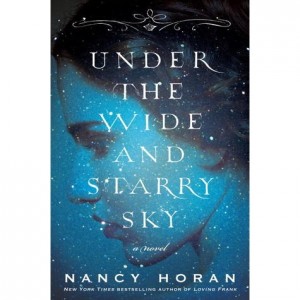A Remarkable Partnership: Nancy Horan’s Under the Wide and Starry Sky
by Sarah Johnson
 “Writing historical fiction about real people allows me to explore the ‘why’ questions that arise out of the facts of the subjects’ lives,” says Nancy Horan. “It allows me to go inside the rooms where they converse and go about their lives, and to feel the tension or warmth in those rooms, to imagine their humanity beyond the biographical facts.”
“Writing historical fiction about real people allows me to explore the ‘why’ questions that arise out of the facts of the subjects’ lives,” says Nancy Horan. “It allows me to go inside the rooms where they converse and go about their lives, and to feel the tension or warmth in those rooms, to imagine their humanity beyond the biographical facts.”
In Under the Wide and Starry Sky, her second historical novel following Loving Frank, she has accomplished this with aplomb. This engrossing epic depicts the passionate union of Scottish writer Robert Louis Stevenson and his American-born wife, Fanny Van de Grift Osbourne. When they first meet at an artists’ colony south of Paris in 1875, Fanny has recently fled her philandering first husband, her children’s father. Her relationship with Louis (as he calls himself) endures despite numerous obstacles in their path, and Horan illustrates its highs and lows as their travels take them around the world.
Many factors attracted her to their story. “The Stevensons were two extraordinary people, made so not only by their natural gifts, but by their spirits and grit as well,” she explains. “Robert Louis Stevenson was often bedbound by a serious lung ailment, yet he was a literary athlete. Fanny, who was ten years older, was forceful in her own way. She appeared fearless on the outside… but she was easily wounded. Time and again she saved Louis’s life. When it was determined that his health improved when he was at sea, Fanny embarked with him on a two- year voyage in the South Seas, despite the fact that she was seasick every day. Once I knew something of their lives, I knew they would be good company for the long run. How could I resist them?”
The novel does much more than reveal the woman behind a famous man, as it explores both Louis’ and Fanny’s perspectives. “I wanted to show how roles can change over time, repeatedly; how beautiful and thorny a long-term love relationship can be… and how you can lose yourself in the institution. But I wanted to explore the strengths too, of long-term commitment and devotion.
“The other part of the decision to give voice to Robert Louis Stevenson is the rich record of feelings he expressed in his letters and works. It was a wonderful opportunity to weave his thinking and some of his words into the text. I wanted the reader to discover how really wonderful he was.”
Crafting scenes from this internationally beloved writer’s viewpoint “was humbling, of course,” Horan says. “But he deserves to be known and remembered. So I dove in. I found his optimism powerful. I think it arose partly from his natural temperament, and partly from a very conscious decision to make each day count… But he had many a depressing day, and it’s a mistake to portray him as only a cheerful person. Remember, he not only wrote A Child’s Garden of Verses, he created the characters of Dr. Jekyll and Mr. Hyde. He didn’t back away from darkness or the complexity of the human personality.”
Although Fanny is fiery and courageous, she still adheres to traditional roles, and Horan’s nuanced portrayal reflects this: “Fanny wrote once that while she believed in women’s rights, she was more of a ‘clinging vine’ type whom activists might disapprove of because she wanted the companionship and protection of a man. In fact, she was a very strong person who exhibited the kind of grit we associate with pioneer women.”
The novel speaks to relevant social issues such as cultural prejudice and the dangers of stereotyping, using Fanny’s nationality and olive complexion and other Europeans’ snobbery toward the native Samoans as examples. “I was aware that Fanny and Louis’s relationship involved a clash of cultures, but I did not anticipate how strongly that theme would play itself out through the rest of the book,” Horan says. “The skin color issue was something Fanny confronted as a child at the hands of her own grandmother, who found her olive skin unattractive…. That experience armed Fanny with a tolerance for differences among other people. Surely it was one of her attractions for Louis, who had suffered for being different and who hated injustice.”
Horan consulted numerous sources for her protagonists’ well-documented lives but “there was plenty of room to improvise,” she states, such as a scene in which Stevenson and his good friend Henry James discuss the subconscious. “Like a biographer, I look at the facts and draw my own conclusions. As a novelist, I am free to draw up scenes that the facts suggest could have happened.”
When asked about her favorites among Stevenson’s oeuvre: “I think Kidnapped and its sequel David Balfour are great,” Horan answers. “Treasure Island and The Strange Case of Dr. Jekyll and Mr. Hyde, of course, and Master of Ballantrae.” In addition to collaborating on some of her husband’s work, Fanny, too, was an author, one of many little-known aspects of her life which Horan has uncovered. Of Fanny’s writings, Horan notes in particular “the Cruise of the Janet Nichol, a non-fiction account of her travels with her husband through the central and western islands of the South Seas. It was a diary, after all, and I think the voice is closest to who she was and what she experienced during one part of her remarkable life.”
About the contributor: Sarah Johnson is HNR’s book review editor.
______________________________________________
Published in Historical Novels Review | Issue 67, February 2014






